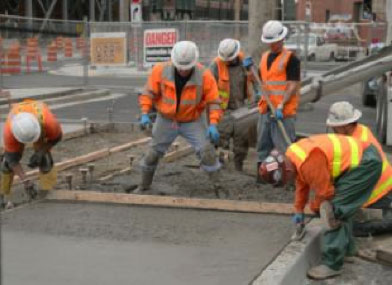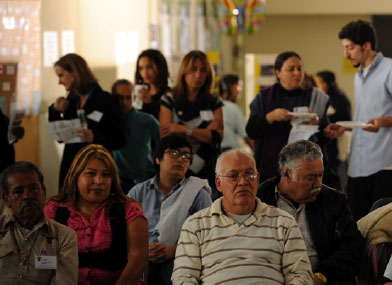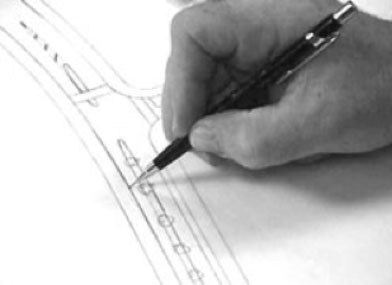Implementation and Resources
Communities are asking that streets do more to accommodate all transportation modes. To better accommodate pedestrians and improve pedestrian safety, communities want to see motor vehicle speeds managed and reduced on their neighborhood streets, streets made more accessible to persons with disabilities, streetscapes that are more attractive and inviting to pedestrians, and more equitable distribution of infrastructural investments. This chapter discusses some of the issues related to setting priorities and developing strategies for implementing pedestrian improvements.
 It is important to incorporate pedestrian facilities in roadway construction projects.
It is important to incorporate pedestrian facilities in roadway construction projects.
Getting Started
“Getting started” can be daunting—the needs are overwhelming, resources are scarce, and staff time is limited. Every community is faced with the questions of “Where do I start?” and “How do I get going?” While it is not the intent of this guide to provide an exhaustive discussion of implementation strategies, some direction is useful.
Priorities
Generally, it is unrealistic to expect that all pedestrian needs can be addressed immediately; therefore project priorities need to be established. To create priorities requires several program objectives:
- Safety. One objective should be to reduce the number and severity of crashes involving pedestrians. To accomplish this will require: (1) a good understanding of the types of crashes that are occurring in your community, (2) a good understanding or where crashes are occurring (i.e. crossing locations, corridors and neighborhoods), and (3) application of appropriate countermeasures to address these crashes. The information provided in this guide is intended to help select the countermeasures that will be most effective in addressing selected types of crash problems.
- Accessibility. A second objective should be to create an accessible community where all pedestrians, including those with disabilities, can reach their desired destinations. Typically, this begins with being able to safely cross streets at intersections and other appropriate locations and walk safely along streets (i.e., sidewalks). Priorities should reflect community values and will typically include access to schools, transit, parks, employment centers and destinations for people with disabilities.
- Aesthetics. It is not enough to simply have a safe, accessible community—it should also be an aesthetically pleasing place to live and work. Landscaping, lighting, and other pedestrian amenities help create a “livable community” and encourage people to walk, and should be considered when making roadway and other improvements along roadways.
- Equity. Issues of equity as it relates to investing in pedestrian infrastructure are becoming increasingly important. Lower income areas that have been traditionally underserved in terms of public and private investment, and where car ownership is typically low, are likely to have a higher number of pedestrians. Taking equity into consideration is another means for prioritizing pedestrian improvements.
- Connectivity. A well connected pedestrian network will allow people to walk to the destinations they need to reach. This means that pedestrian pathways should connect to public institutions (schools, parks, post offices, etc.), as well as homes, employers, stores, restaurants, and transit. Furthermore, pedestrians should not have to make significant detours. A well connected network will provide reasonably direct walking routes between destinations.
One Step at a Time
To create a safe, walkable community, take one step at a time. Sidewalks, curb bulb-outs, and other pedestrian improvements are installed intersection by intersection, block by block. Improvements are often made at multiple locations along an entire corridor. Individually, they do not create a safe, livable community. Collectively, they create the infrastructure needed for a great place to work, play, and do business. In other words, the whole pedestrian system is greater than the sum of its parts.
 Public participation will build community pride and buy-in that is essential to create a safe, walkable community. Source: Trust for South L.A.
Public participation will build community pride and buy-in that is essential to create a safe, walkable community. Source: Trust for South L.A.
Community Concerns
Be sensitive to community concerns. Public participation will build community pride and buy-in that is essential to long-term success. Some of the problems identified in this guide will not be an issue in your community and some of the tools may be perceived as infeasible (at least initially). There probably will be measures that your community puts on hold for a few years until a community consensus is reached. Conversely, there probably will be measures that your community would like to pursue that are not even mentioned in this planning guide. There may also be measures that can be installed on a temporary or interim basis to determine community acceptance.
Results
It is important to produce immediate results that people can see. For example, a new section of sidewalk or a freshly painted crosswalk is visible, while a transportation plan is a paper document that may never be seen or appreciated by the public. To keep its momentum, a program needs some “quick wins.” They create the sense that something is happening and that government is responsive.
 It is important to produce immediate results that people can see
It is important to produce immediate results that people can see
Implementation Strategies
There are many ways to accomplish projects. Be creative; take advantage of opportunities as they present themselves. Here are some suggestions:
Routine Accommodation
“Piggybacking” pedestrian improvements onto capital projects are one of the best ways to make major improvements in a community. Sidewalks, pedestrian ramps, landscaping, lighting, and other amenities can be included in road projects, utility projects, and private construction in public rights-of-way (e.g., cable television, high-speed fiber optics, etc.). To accomplish this, there are several things that can be done:
- Contact all state and regional agencies, and local public and private utilities that do work in public rights-of-way. Secure their 5-year project plans as well as their long-range plans. Then, work with them to make sure that the streets are restored in the way that works for your city.
- Look internally at all capital projects. Make sure that every opportunity to make improvements is taken advantage of at the time of construction.
- Consider combining small projects with larger capital projects as a way of saving money. Generally, bid prices drop as quantities increase.
Annual Programs
Consider expanding/initiating annual programs to make small, visible improvements on a regular basis. Examples include sidewalk replacement programs, curb-ramp programs, annual tree-planting programs, etc. This creates momentum and community support. Several considerations should be made when developing these programs:
- Give priority to locations that are used by schoolchildren, the elderly, those with disabilities, areas that have been underserved, and locations that provide access to transit.
- Consider giving preference to requests from neighborhood groups, especially those that meet other priorities, such as addressing a crash problem.
- Evaluate your construction options. Consider having city crews do work requested by citizens to provide fast customer service while bidding out some of the staff-generated projects.
Public/Private Partnerships
Increasingly, public improvements are realized through public/private partnerships. These partnerships can take many forms. Examples include: community development corporations, neighborhood organizations, grants from foundations, direct industry support, and involvement of individual citizens. In fact, many public projects, whether they are traffic-calming improvements, street trees, or the restoration of historic buildings, are the result of individual people getting involved and deciding to make a difference. This involvement doesn’t just happen, it needs to be encouraged and supported by local governmental authorities.
Developer Requirements and Incentives
Developers can be required to install public infrastructure such as sidewalks, curb ramps, and traffic signals. In addition, zoning requirements can be written to support more pedestrian-friendly communities by allowing for, incentivizing, or requiring, narrower streets, shorter blocks, frontage improvements that enhance aesthetics and functionality of the pedestrian zone, and mixed-use development. Encouraging developers and community leaders to focus on basic pedestrian needs will benefit the community and increase the attractiveness and marketability of the developments themselves.
Pedestrian Safety Resources
Access Issues
An introduction to accessibility and universal design:
A more comprehensive set of guidelines for achieving full accessibility from the US Access Board:
Aesthetics
California’s Local Government Commission has some great resources on street design and livability.
Other Pedestrian Safety Resources
- How to Develop a Pedestrian Safety Action Plan (Order a hard copy of the guide here)
- International Scan Summary Report
- Traffic Calming Resources
- Toolbox of Countermeasures
- Context Sensitive Solutions Guide
- PBIC Case Studies
- Accessible Public Rights of Way (PDF, 2.3 MB)
- An Analysis of Factors Contributing to "Walking Along Roadway" Crashes: Research Study and Guidelines for Sidewalks and Walkways (PDF, 599 KB)
- Chicago Pedestrian-Motor Vehicle Collisions 2001–2005: Crash Factors and Spatial Analyses (PDF, 4.4 MB)
- Designing Sidewalks and Trails for Access: Part I (PDF, 29.6 MB)
- Designing Sidewalks and Trails for Access: Part II (PDF, 30.4 MB)
- Effects of Traffic Calming Measures on Pedestrian and Motorist Behavior (PDF, 883 KB)
- Evaluation of the Miami-Dade Pedestrian Safety Demonstration Project (PDF, 5.1 MB)
- Information Report on Lighting Design for Midblock Crosswalks (PDF, 944 KB)
- NCHRP Report 500: Volume 10: A Guide for Reducing Collisions Involving Pedestrians (PDF, 3.2 MB)
- Pedestrian and Bicycle Crash Analysis Tool (PBCAT) (PDF, 2.2 MB)
- Pedestrian Road Safety Audit Guidelines and Prompt Lists (PDF, 4.4 MB)
- Pedestrian Safety Guide for Transit Agencies (PDF, 2.7 MB)
- Residents Guide for Creating Safe and Walkable Communities (PDF, 3.7 MB)
- Review of Pedestrian Safety Research in US and Abroad (PDF, 7.3 MB)
- Safety Effects of Marked versus Unmarked Crosswalks at Uncontrolled Locations (PDF, 715 KB)
- Toolbox of Countermeasures and Their Potential Effectiveness for Pedestrian Crashes (PDF, 827 KB)
- Walkability Checklist (PDF, 198 KB)
- PBIC Livable Communities Webinars
Local Resources and Examples
Many cities have adopted plans and procedures to ensure that pedestrian improvements become a routine activity in new development projects, reconstruction work, and retrofits. Comprehensive information about state and local plans, policies, case studies, and other information can be found in this database of State Resources. Listed below are just a few examples of organizations with exemplary programs and plans:
States
- Arizona Pedestrian Safety Action Plan Study
- New Jersey Safety along Railroads - Short-Term Action Plan
- New Jersey Complete Streets Training Curriculum
- Evaluation of the Automated Red Light Enforcement (ARLE) Program in Pennsylvania
Cities/Counties
- Boston, MA Complete Streets
- Cambridge, MA
- City of Seattle Pedestrian Program
- City of Portland Pedestrian Information
- Greensboro, NC Pedestrian Program
- New York City Pedestrian Safety Study and Action Plan
- Pinellas County Pedestrian Safety Action Plan
- Hillsborough County Pedestrian Safety Action Plan
- Phoenix Pedestrian Safety Action Plan
- Philadelphia Parklet Guidelines - How to Turn a Parking Space into a Parklet
- Philadelphia Pedestrian and Bicycle Plan
- San Francisco Better Streets Plan
- San Francisco WalkFirst Pedestrian Priority Study - This report designated priority streets for safety and walkability improvements based on injury density patterns and actual/potential pedestrian volumes.
Other Local Resources
America Walks, a national coalition of pedestrian advocacy groups, has developed a variety of resources that focus on results and implementation.
Walk Score is an on-line resource that uses factors such as density of land-uses and amenities and mixes of incomes and development types to measure walkability.
Additional Information

